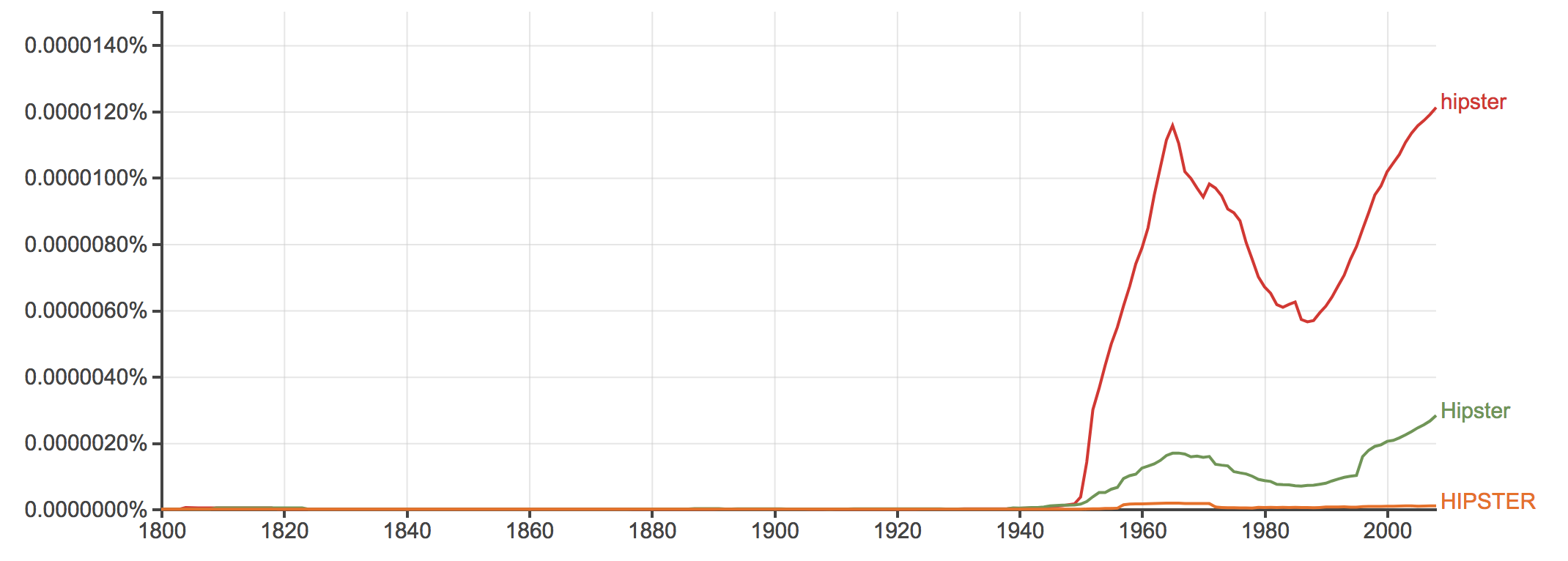The Beginning
The term ‘hipster’ originated in the 1930s. But, as many things that started back then, the word has changed meaning since its conception. Originally meaning “female jazz person”, the term later evolved to signify “fashionable person in the jazz world” and is now defined as “a person who is unusually aware of and interested in new and unconventional patterns (as in jazz or fashion)”.
The essence of the hipster lifestyle has always been being different. Hipsters are notorious for their quirky fashion sense characterized by brightly colored socks that peek out beneath cuffed jeans, round glasses, and patterned shirts; their innate ability to grow impressive beards; their obsession with veganism and kale chips; and their extremely left leaning political views. In other words, hipsters are a millennial-aged group focused on diverting from the norm.
Diverging from the mainstream
The chart below shows how hard hipsters have tried to stray from the mainstream: abandoning even the use of capital letters in defining their subculture. The use of the all lowercase ‘hipster’ is much more common than the grammatically correct ‘Hipster’ and, not surprisingly, significantly more widespread than the all caps ‘HIPSTER’. This nuance speaks to the minute details that characterize this group.

“I sued American Apparel because they calculatingly took my name, my likeness and image and used them publicly to promote their business.” – Woody Allen
However, in recent years, being hipster has become so popular that it has almost become the mainstream. This transition is most evident in the fashion world. While not all people who have adopted the grunge look are true members of the hipster subculture, their fashion choices are beginning to align them as such. Mainstream name brands such as Urban Outfitters, Free People, and American Apparel have all begun marketing to this demographic.
Globalization
In addition to fashion trends, entire cities are now thriving due to the influx of the hipster subculture. In the United States, areas such as Brooklyn, NY and Portland, OR have become popular hubs for these millennials. Seen as affordable, up-and-coming, trendy neighborhoods, the hipster generation has flocked to these cities as a means of furthering their idea of self expression.
Though what was originally a local phenomenon characterized by street art, live music venues, and endless craft beer and coffee shops, the idea of the hipster city is rapidly spreading, influencing countries across the globe. Helen Coffey from Independent has even gone so far as to say that “craft beer and artisan coffee is leading to homogenized cities the world over” after reflecting upon her experiences in Vietnam.
Denial
Hipsters are a funny group, though. On the one hand, they purposefully dress to fit the description and hold interest in alternative music and other art forms. But on the other, hipsters constantly deny the fact that they are hipsters.
“Nobody hates hipsters more than hipsters.” – Tim Heidecker
A recent Westword study concluded the reason for this dissonance. The term is now seen as nothing more than a marketing label, something hipsters despise. Any attempt to commercialize their brand is automatically seen as counter-culture. While once a proudly worn label of the group, the term is now seen as an almost insulting definition, clumping the true outcasts amongst the sea of wannabes.

